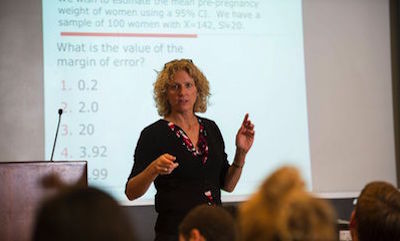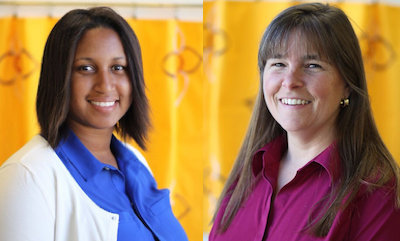Undergraduate Program Builds Pipeline of Biostatisticians.

A program at the School of Public Health to build a pipeline of biostatisticians has received a National Institutes of Health (NIH) grant to continue through 2018.
The U.S. has been facing a biostatistician shortage for decades. To narrow the gap, in 2003 the NIH’s Heart, Lung, and Blood Institute initiated Summer Institute for Training in Biostatistics (SIBS) programs at three schools around the country, including BUSPH.
The six-week summer program is an intensive introduction to the field, exposing undergraduate students to the principles, methodologies, uses, and applications of biostatistics in biomedical and clinical research.
“It’s unusual in a grant that you can demonstrate your success,” says Lisa Sullivan, professor of biostatistics, who led the program with Anita DeStefano for the first four grant cycles.
With the SIBS program, Sullivan says, the results have been apparent well before each grant ends: the participants “are juniors or seniors when they come, they go back to their home school, and we track them, and we know we’ve had over 75 percent of these students go into the field.”
With 24 participants per year—out of over 200 applicants—that’s a significant pipeline of new biostatisticians. Many do so with a master’s or doctorate from SPH.
The SIBS program makes the field of biostatistics real for students, says Jacqueline Milton (’14), clinical assistant professor of biostatistics, who will run the program with DeStefano next summer. “We have a lot of students who are math majors, biology or chemistry majors, and they know they might have an interest in applying quantitative methods to the biomedical sciences but they don’t really realize what kinds of options are out there,” she explains. “That’s what this program is for.”

That was the case for Avery McIntosh, now a biostatistics doctoral candidate at SPH. “SIBS marked the transition from my being a mathematician to a biostatistician,” he says. “I was interested in using my interest in math to tackle social and economic problems, but I was unsure what avenue of study to pursue.
“While attending SIBS I was able to meet clinical researchers, government administrators, and statisticians from a contract research organization,” McIntosh recalls.
“It also allowed me to meet and talk with people at the forefront of biostatistics research,” he adds, noting how exciting it was to work closely with faculty in the program.
Amarachi Umez-Eronini (’11) participated in SIBS the summer before starting her MPH, and says the program helped convince her she had chosen the right career path. “I needed to explore more, learn more about it,” she says. “When it came down to accepting admission to the School of Public Health or taking an opportunity to play professional basketball, I chose the MPH!”
The biostatistician and statistical programmer at clinical research organization Prometrika says the program also served as an excellent launchpad to a career in biostatistics.
SIBS taught “the importance of having a critical eye going into studies, and when you receive data,” she says.
“It prepared us to exercise good statistical judgment, and that’s something that I use to this day.”
For the BUSPH SIBS program, that critical eye looks at more than numbers. “There’s a goal of increasing the diversity among biostatisticians,” explains DeStefano, “to get more underrepresented minority students and first-generation college students to be aware of the field of biostatistics and the impact they can make on public health and health research.”
She says that plays a role both in recruiting participants, and in the data sets students work with in the program.
BUSPH SIBS has partnered with the Jackson Heart Study, giving program participants the opportunity to work with data sets from the largest study ever to investigate the genetic factors that affect high blood pressure, heart disease, strokes, diabetes and other important diseases in African Americans.
DeStefano says it’s vital “for all biostatisticians to be thinking about diversity within populations being studied, and the ethics around that. Those are also issues that we try to bring into the SIBS program.”